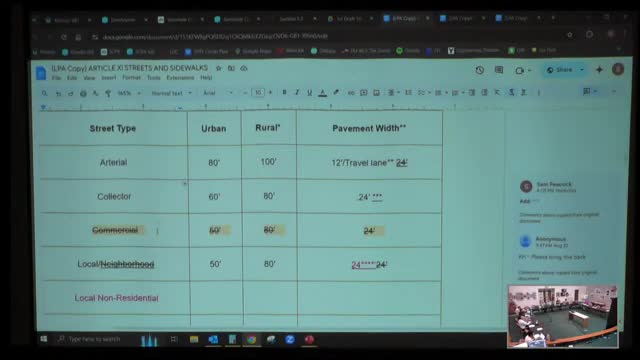City plans to narrow roads for safer biking and walking
August 29, 2024 | Oviedo, Seminole County, Florida
This article was created by AI summarizing key points discussed. AI makes mistakes, so for full details and context, please refer to the video of the full meeting. Please report any errors so we can fix them. Report an error »

During a recent government meeting, officials discussed significant changes to local road design standards aimed at enhancing safety and promoting alternative transportation methods. The conversation centered on the potential reduction of pavement widths for collector and local roads, from 24 feet to 22 feet, contingent upon approval from the city engineer. This proposal aligns with a growing trend in urban planning that advocates for narrower lanes, which are believed to serve as effective traffic calming measures.
Members of the Local Development Committee (LDC) expressed support for narrower lanes, citing safety benefits and the need to allocate road space for bike lanes and paths. The Orlando metropolitan area has been identified as having the highest fatality rates in the country, underscoring the urgency of these discussions. Officials emphasized the importance of aligning infrastructure with the city’s goals of encouraging walking and biking, thereby reducing reliance on vehicles.
The meeting also addressed the implementation of shared lanes, or \"sharrows,\" which are designated for both bicycles and vehicles. These markings would be required on streets with speed limits of 25 miles per hour or lower, although concerns were raised about the financial implications of mandating such markings across all city streets. Officials acknowledged the need for clarity on where these shared lanes should be implemented, suggesting that they might be more appropriate on main arteries rather than in every subdivision.
Additionally, the discussion touched on the requirement for bicycle lanes in residential areas, particularly in subdivisions with fewer than 100 homes. The current language in the code may be revised to reflect the realities of speed limits and road usage in these neighborhoods.
Overall, the meeting highlighted a commitment to improving road safety and accommodating diverse transportation options, with plans to further clarify and refine the proposed changes in future discussions.
Members of the Local Development Committee (LDC) expressed support for narrower lanes, citing safety benefits and the need to allocate road space for bike lanes and paths. The Orlando metropolitan area has been identified as having the highest fatality rates in the country, underscoring the urgency of these discussions. Officials emphasized the importance of aligning infrastructure with the city’s goals of encouraging walking and biking, thereby reducing reliance on vehicles.
The meeting also addressed the implementation of shared lanes, or \"sharrows,\" which are designated for both bicycles and vehicles. These markings would be required on streets with speed limits of 25 miles per hour or lower, although concerns were raised about the financial implications of mandating such markings across all city streets. Officials acknowledged the need for clarity on where these shared lanes should be implemented, suggesting that they might be more appropriate on main arteries rather than in every subdivision.
Additionally, the discussion touched on the requirement for bicycle lanes in residential areas, particularly in subdivisions with fewer than 100 homes. The current language in the code may be revised to reflect the realities of speed limits and road usage in these neighborhoods.
Overall, the meeting highlighted a commitment to improving road safety and accommodating diverse transportation options, with plans to further clarify and refine the proposed changes in future discussions.
View full meeting
This article is based on a recent meeting—watch the full video and explore the complete transcript for deeper insights into the discussion.
View full meeting